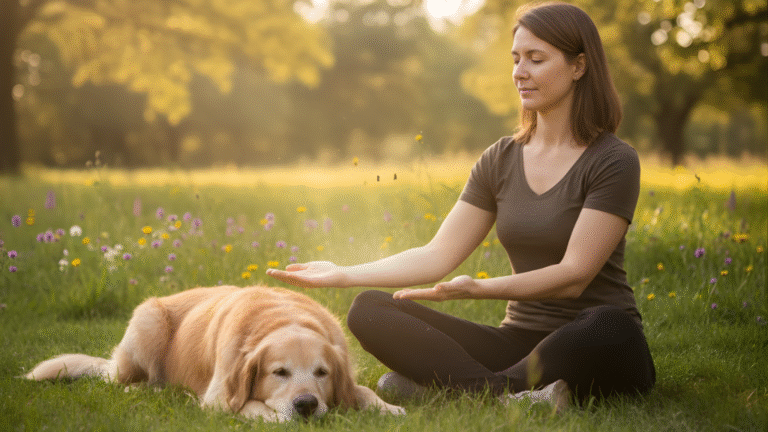Hands-On vs Hands-Off Reiki: What Works Best For Animals?
Reiki for animals is becoming increasingly popular among pet lovers, holistic practitioners, and animal caregivers. At its heart, Reiki is a gentle energy-healing method used to create calm, support emotional balance, and encourage the natural healing processes within the body.
When we offer Reiki to animals, we can do it in two main ways: hands-on or hands-off. This comparison—often referred to as Hands-On vs Hands-Off Reiki—helps us understand how different styles affect the animal’s comfort and response.
If you’re just beginning your Reiki journey or are curious about how to support your pets in the best possible way, understanding these two styles is incredibly helpful.
Over the years, working with animals in shelters, rescues, and at home, I’ve learned how much they appreciate having choice and control during a Reiki session.
Some animals melt into gentle touch, while others feel safer with energy offered from a small distance. In this guide, we’ll explore both approaches so you can easily recognize which one your animal prefers and why.
What Is Animal Reiki?
Animal Reiki is a calming healing method that supports emotional well-being, reduces stress, and helps activate the body’s natural ability to heal.
It can be shared with pets, farm animals, wildlife, and even animals in rehabilitation or long-term care. Because it’s gentle and non-invasive, animals often respond extremely well to it.
One of the reasons Animal Reiki works so beautifully is that it respects each animal’s unique personality and comfort level. Some animals enjoy soft hands-on contact.
Others—especially rescues, traumatized pets, or animals recovering from illness—prefer energy from a safe distance. There is no “right” or “wrong” approach. Reiki simply adapts to the animal in front of you.
People use Animal Reiki in many situations: comforting a newly adopted pet, helping a dog settle after a stressful day, supporting a horse recovering from injury, or easing anxiety in a cat who struggles with change. Regardless of the method, the intention is always the same—peace, balance, and comfort.
Understanding Hands-On vs Hands-Off Reiki
Hands-on and hands-off Reiki come from the same foundation: offering calming energy meant to reduce stress and support natural healing. The difference lies in how close your hands are to the animal.
Hands-On Reiki
The practitioner gently places their hands on safe, comfortable areas like the shoulders, back, or chest. Animals who enjoy touch and trust their caregiver often find hands-on Reiki grounding and soothing.
Hands-Off Reiki
The practitioner keeps their hands a short distance above the body with no physical contact. This style is ideal for anxious, fearful, injured, or touch-sensitive animals.
It’s also used in shelters, barns, or medical situations where direct touch isn’t allowed. Neither method is better than the other. Animals decide what feels supportive moment by moment.
Some switch between the two during the same session. Others prefer one style for months before trying the other. Reiki simply meets the animal where they are.
When Does Each Approach Work Best?
Your animal’s personality, history, and current state all influence how they respond to Reiki. Choosing a method becomes much easier once you understand how different situations affect their comfort level.
Hands-On Reiki
Wonderful for relaxed animals who enjoy touch. Older dogs, cuddly cats, confident horses, and bonded pets often settle quickly during gentle hands-on sessions.
It can also feel emotionally supportive for animals recovering from illness—provided touching the area is comfortable and safe.
Hands-Off Reiki
Best for shy, fearful, or traumatized animals. This includes rescues, newly adopted pets, animals with past negative experiences, or those currently healing from medical procedures.
Hands-off Reiki is also ideal for large animals, wildlife, and animals in situations where physical contact isn’t possible. Some of the most profound shifts I’ve seen have happened during hands-off sessions.
When animals are given complete control—without pressure to be touched—they gradually soften, breathe more deeply, and allow the energy to reach them in a way that feels safe.
Want to Share Your Love for Pet Reiki?
Discover how rewarding it can be to bring healing energy and compassion to pets — and to share that passion online with others.
🌟 Please read: How to Make Money Within the Pet Reiki NicheHow To Tell What Your Animal Prefers
Animals communicate constantly through their posture, facial expressions, breathing, and subtle changes in behaviour. When offering Reiki, paying attention to these cues helps you understand whether your pet wants hands-on support, hands-off space, or a mix of both.
Comfortable animals often soften around you. Their muscles relax, their breathing slows, and they may gently lean closer. Curious pets might inch toward your hands, blink slowly, or shift their weight in a way that says, “I feel safe here.” These are encouraging signs that your animal is receptive to hands-on Reiki.
On the other hand, pets who prefer hands-off Reiki usually show signs of needing more space. Moving away, flattening their ears, licking their lips, twitching their tail, or glancing away can indicate discomfort.
These are not adverse reactions—they’re simply the animal’s way of guiding you. Respecting their signals builds deep trust over time.
If you’d like help reading subtle cues, the ASPCA’s body language guide is an excellent resource for learning about relaxed versus stressed behaviours in animals.
For a deeper look at why many animal practitioners prefer letting animals choose touch, you can explore this helpful guide from Animal Reiki Source.
Benefits Of Hands-On Reiki
Hands-on Reiki can be especially soothing for animals who love human contact. Touch carries emotional warmth, and many animals respond with instant calm when a trusted person places a gentle hand on them.
1. Deep Relaxation
Some animals quickly drift into a peaceful, meditative state when touched, similar to how humans feel during a calming massage.
If you're curious about the scientific side of Reiki, this PubMed Central study offers an easy-to-read overview.
2. Stronger Bonding
Physical contact reinforces trust and strengthens your relationship with your pet.
3. Comfort During Illness
Many older or chronically ill animals seek gentle touch because it brings reassurance and helps them feel supported.
4. Focused Intention
When permitted, placing hands near an area of discomfort can help guide your intention and encourage deeper healing.
With hands-on Reiki, the golden rule always applies: ask for permission through observation, not assumptions. Watch for signs your pet welcomes touch before placing your hands on them.
Benefits Of Hands-Off Reiki
Hands-off Reiki is not just an alternative approach—it’s a powerful method in its own right. Many animals who don’t tolerate touch become deeply receptive when energy is offered from a respectful distance.
1. Ideal For Nervous Or Fearful Animals
Rescue pets, newly adopted animals, and animals with past trauma often need space before they feel safe.
2. Safe For Injured Or Recovering Animals
When touching is painful or risky, hands-off Reiki provides gentle support without disturbing sensitive areas.
3. Flexible For All Environments
It works beautifully in shelters, barns, wildlife centres, or anywhere touch isn't possible.
4. Encourages Empowerment
The animal decides how close they want to be, giving them complete control of the experience.
Many of the deepest breakthroughs I’ve witnessed happened with hands-off Reiki. Animals who initially want nothing to do with human contact often relax, soften, and—over time—begin to approach on their own terms.
If you'd like a simple, beginner-friendly breakdown of what Reiki looks like for everyday pets, you may enjoy this article from Julie Pet Connect.
Practical Steps To Get Started With Animal Reiki
Whether you’re new to Reiki or ready to explore both styles with your pet, starting with a thoughtful setup helps your animal feel comfortable and secure.
1. Create A Peaceful Space
Choose a quiet location with minimal distractions. Soft lighting, gentle sounds, and familiar scents help animals feel grounded.
2. Let Your Pet Approach
Sit quietly with an open, calm posture. Animals will move closer if they feel ready. Never force engagement.
3. Begin With Hands-Off Reiki
Hold your palms a short distance away from your pet and watch how they respond.
4. Follow Their Cues
If your pet leans in, relaxes, or moves closer, you may gently offer hands-on contact—if they’re clearly comfortable.
5. Keep Sessions Short
Five to fifteen minutes is perfect for beginners. Extend only if your pet remains relaxed and engaged.
6. End Positively
Offer affection, praise, treats, or quiet time—whatever your pet enjoys most.
Think of each session as a fresh experience. Animals change day to day, and their preferences shift depending on how they’re feeling in the moment.
Common Challenges And How To Navigate Them
Even with a gentle approach, Reiki sessions can unfold in unexpected ways. These challenges are completely normal and reflect your animal’s personality and comfort level.
1. Your Animal Avoids You
Don’t take it personally. Fear, unfamiliarity, or mood fluctuations can affect how an animal responds. Try again another day or send Reiki from across the room.
2. Restlessness Or Fidgeting
This may signal excess energy. Give your pet more space or shorten the session. Over time, they’ll settle more quickly.
3. Uncertainty In Your Abilities
Almost everyone doubts themselves in the beginning. Stay patient. Even small signs of softening—like calmer breathing—are meaningful.
The key is always gentle observation and adaptation. When you let your animal guide the process, every session builds trust and brings a deeper connection. They often relax deeply and begin trusting much faster.
For a balanced look at what current studies say about Reiki for animals, visit Pawsitive Healing Energy.
Frequently Asked Questions
Q1: Can I Switch Between Hands-On And Hands-Off Reiki In The Same Session?
Absolutely. Many practitioners blend both approaches depending on how the animal responds in the moment. You may begin with hands off while the animal settles and shift to gentle touch if they approach you or show signs of comfort. Flexibility keeps the session animal-led and respectful.
Q2: How Long Does A Typical Reiki Session Last?
Most sessions range from ten to thirty minutes. Some animals enjoy longer sessions, but shorter intervals often work best for nervous or first-time pets. Let the animal guide the timing—when they get up, walk away, or settle into a deep rest, that’s your cue.
Q3: What If My Pet Falls Asleep During Reiki?
That’s perfectly normal. Sleep is a sign of deep relaxation and trust. Let them rest as long as they want, and avoid waking them abruptly. When they wake naturally, offer a calm transition back to normal activity.
Q4: Is Reiki Safe For Animals With Chronic Illnesses Or Injuries?
Yes. Reiki is non-invasive and gentle, making it a supportive option for pets dealing with long-term conditions, pain, or mobility issues.
Always stay in communication with your veterinarian, especially when health concerns are involved, to ensure the Reiki session aligns with ongoing medical care.
Q5: Can I Practice Reiki On Animals If I’m Not Certified?
Yes, you can offer simple, gentle Reiki to your own pets without certification. Many people start by learning basic techniques from books or videos.
Certification becomes more important if you plan to work with other people’s animals, volunteer in shelters, or offer Reiki professionally.
Q6: How Do I Know If My Pet Is Receiving The Energy?
Animals respond in subtle ways. Signs may include sighing, stretching, softening their eyes, lying down, grooming, or slowly moving closer to you.
Some pets simply rest quietly nearby. Every animal reacts differently, and even small shifts often indicate they’re connecting with the energy.
Q7: Is It Normal For My Pet To Walk Away During Reiki?
Completely normal. Walking away is a form of communication, not rejection. Your pet may need a break, or the energy may feel strong. Allowing them to come and go freely builds trust and keeps the session respectful and animal-led.
Q8: How Can I Make Reiki Part Of My Pet’s Wellness Routine?
Start small—offer short hands-off sessions once or twice a week in a quiet space your pet enjoys. Combine Reiki with gentle routines your pet already loves, such as brushing or cuddle time.
Over time, sessions often become something pets look forward to, especially when they associate Reiki with relaxation and safety.
Q9: Can Reiki Help Pets With Past Trauma Or Emotional Wounds?
Yes, Reiki can be very soothing for pets with difficult histories. Many rescue animals respond well to the gentle, non-invasive nature of Reiki because it doesn’t force touch or interaction. Over time, it can help reduce fear responses, build trust, and create a sense of emotional safety.
Q10: How Long Does It Take To See Results From Reiki Sessions?
Some pets relax within minutes, while others need several short sessions before showing noticeable changes. Progress depends on personality, history, and comfort level.
Look for small signs first—sighs, softer posture, increased closeness, or better sleep. Those subtle shifts often build into bigger improvements over time.
Q11: Is It Normal If My Pet Seems Extra Tired After A Reiki Session?
Yes, many pets feel sleepy or extra relaxed afterward. This is a natural response to releasing tension and settling into a calmer state. Let them rest if they want to — it usually means the session helped their body and mind unwind.
Q12: Can Multiple Pets Receive Reiki At The Same Time?
They can, but it depends on the animals. Some pets enjoy the shared calm energy, while others prefer one-on-one attention. If you’re trying group Reiki at home, start slowly. Watch everyone’s behaviour and give each animal the option to move away if they prefer personal space.
Q13: Can Reiki Help Newly Adopted Or Rescued Animals Adjust More Easily?
Absolutely. Many newly adopted pets arrive with emotional baggage — fear, uncertainty, or trouble trusting their new environment. Reiki offers a gentle way to ease that transition.
It helps them settle, reduces overwhelm, and gives them a sense of safety during those first few weeks. Even short sessions can make a real difference in helping them feel at home.
Q14: Is Distance Reiki Effective For Animals Who Don’t Live With Me?
Yes, many practitioners use distance Reiki for pets who are far away, hospitalized, or difficult to approach. Animals tend to respond well because they don’t feel pressured or crowded. It’s a great option when in-person sessions aren’t possible, yet you still want to send calming, supportive energy.
Wrapping Up
Hands-on and hands-off Reiki each offer meaningful benefits for animals, and neither approach is “better” than the other. What matters most is your animal’s comfort, their emotional state, and how they communicate during each session.
Some pets crave gentle touch; others prefer the spacious calm of hands-off energy work. Allowing your pet to choose creates trust, deepens your bond, and leads to richer healing experiences over time.
Whether you’re working with a confident family pet, a shy rescue, or a sensitive senior animal, tuning into their cues will help you adjust the session so it feels safe, soothing, and respectful. Many pet owners find that the more they practice Reiki with their animals, the more intuitive the process becomes.
I trust you enjoyed this article on Hands-On vs Hands-Off Reiki: What Works Best For Animals?. Please stay tuned for more Reiki insights, pet wellness tips, and holistic lifestyle ideas.
Take care!
— JeannetteZ
💬 Your Opinion Is Important To Me
Do you have thoughts, ideas, or questions? I’d love to hear from you. Please leave your comments below or email me directly at Jeannette@pawreiki.com.
📚 More PawReiki Reads — Discover Energy Healing & Holistic Pet Wellness
💜 My #1 Recommendation for Online Success
Reiki has brought so much peace and purpose to my life, and sharing it online has been a true blessing. If you’ve ever dreamed of creating a gentle income stream around your love for animals and holistic healing, this platform gives you all the tools, training, and community support you need — no tech experience required.
🌟 See How Reiki Lovers Build Online Income — Try WA FreeNo credit card required · Free starter training included
Disclosure
This post may contain affiliate links. As an Amazon Associate and participant in other affiliate programs, I earn from qualifying purchases at no extra cost to you. Please read my full affiliate disclosure.







